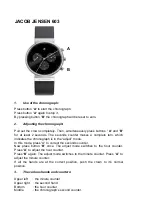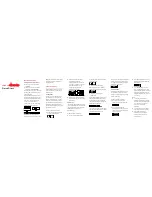
Heart Rate Features
19
Color Zone
Red
Orange
Green
Orange
Red
Symmetry
Poor
Fair
Good
Fair
Poor
Percent of Other Runners
5%
25%
40%
25%
5%
Ground Contact Time Balance
>52.2% L
50.8–52.2% L
50.7% L–50.7% R
50.8–52.2% R
>52.2% R
While developing and testing running dynamics, the Garmin team found correlations between injuries and greater imbalances
with certain runners. For many runners, ground contact time balance tends to deviate further from 50–50 when running up or
down hills. Most running coaches agree that a symmetrical running form is good. Elite runners tend to have quick and balanced
strides.
You can watch the color gauge or data field during your run or view the summary on your Garmin Connect account after your
run. As with the other running dynamics data, ground contact time balance is a quantitative measurement to help you learn
about your running form.
Vertical Oscillation and Vertical Ratio Data
The data ranges for vertical oscillation and vertical ratio are slightly different depending on the sensor and whether
it is positioned at the chest (HRM-Tri or HRM-Run accessories) or at the waist (Running Dynamics Pod accessory).
Color Zone
Percentile in
Zone
Vertical Oscillation
Range at Chest
Vertical Oscillation
Range at Waist
Vertical Ratio at
Chest
Vertical Ratio at
Waist
Purple
>95
<6.4 cm
<6.8 cm
<6.1%
<6.5%
Blue
70–95
6.4–8.1 cm
6.8–8.9 cm
6.1–7.4%
6.5–8.3%
Green
30–69
8.2–9.7 cm
9.0–10.9 cm
7.5–8.6%
8.4–10.0%
Orange
5–29
9.8–11.5 cm
11.0–13.0 cm
8.7–10.1%
10.1–11.9%
Red
<5
>11.5 cm
>13.0 cm
>10.1%
>11.9%
Tips for Missing Running Dynamics Data
If running dynamics data does not appear, you can try
these tips.
Make sure you have a running dynamics accessory, such
as the HRM-Tri accessory.
Accessories with running dynamics have on the front
of the module.
Pair the running dynamics accessory with your
fēnix device again, according to the instructions.
If the running dynamics data display shows only zeros,
make sure the accessory is worn right-side up.
NOTE:
Ground contact time and balance appears only
while running. It is not calculated while walking.
Performance Measurements
These performance measurements are estimates that can
help you track and understand your training activities and
race performances. The measurements require a few
activities using wrist-based heart rate or a compatible chest
heart rate monitor. Cycling performance measurements
require a heart rate monitor and a power meter.
These estimates are provided and supported by Firstbeat.
For more information, go to
NOTE:
The estimates may seem inaccurate at first. The
device requires you to complete a few activities to learn
about your performance.
VO2 max
�
:
VO2 max. is the maximum volume of oxygen
(in milliliters) you can consume per minute per kilogram
of body weight at your maximum performance.
Predicted race times:
Your device uses the VO2 max.
estimate and your training history to provide a target
race time based on your current state of fitness.
HRV stress test:
The heart rate variability (HRV) stress test
requires a Garmin chest heart rate monitor.
The device records your heart rate variability while
standing still for 3 minutes. It provides your overall
stress level. The scale is 1 to 100, and a lower score
indicates a lower stress level.
Performance condition:
Your performance condition is a
real- time assessment after 6 to 20 minutes of activity. It
can be added as a data field so you can
view your performance condition during the rest of your
activity. It compares your real-time condition to your
average fitness level.
Functional threshold power (FTP):
The device uses your
user profile information from the initial setup to
estimate your FTP. For a more accurate rating, you can
conduct a guided test.
Lactate threshold:
Lactate threshold requires a chest heart
rate monitor. Lactate threshold is the point where your
muscles start to rapidly fatigue. Your device measures
your lactate threshold level using heart rate data and
pace.
















































